Nellcor OxiMax N-600x Service manual

Service Manual
NellcorTM
OxiMax N-600x
Pulse Oximeter
OxiMaxTM
Technology
COVIDIEN, COVIDIEN with logo, the Covidien logo and positive results for life are U.S. and internationally registered trademarks of Covidien AG. Other brands are trademarks of a Covidien company. ©2011 Covidien.
U.S. Patents 5,485,847; 5,676,141; 5,743,263; 6,035,223; 6,226,539; 6,411,833; 6,463,310; 6,591,123; 6,708,049; 7,016,715; 7,039,538; 7,120,479; 7,120,480; 7,142,142; 7,162,288; 7,190,985; 7,194,293; 7,209,774; 7,212,847; 7,400,919.
To obtain information about a warranty, if any, contact Covidien Technical Services at 1.800.635.5267 or your local representative.
Purchase of this instrument confers no express or implied license under any Covidien patent to use the instrument with any pulse oximeter that is not manufactured or licensed by Covidien.

Contents
C o n t e n t s
Introduction . . . . . . . . . . . . . . . . . . . . . . . . . . . . . . . . . . . . . . . . . . . . . . . . 1
Warnings ............................................................................................................... |
1 |
Cautions ................................................................................................................ |
3 |
Overview ............................................................................................................... |
4 |
Monitor Description ............................................................................................... |
4 |
Front Panel ................................................................................................. |
5 |
Rear Panel ................................................................................................. |
6 |
Softkey Menu ............................................................................................. |
6 |
Related Documents ............................................................................................ |
10 |
Routine Maintenance . . . . . . . . . . . . . . . . . . . . . . . . . . . . . . . . . . . . . . . . 11
Cleaning the Monitor ........................................................................................... |
11 |
Periodic Safety Checks ....................................................................................... |
12 |
Functional Checks .............................................................................................. |
12 |
Battery Operation ................................................................................................ |
13 |
Performance Verification . . . . . . . . . . . . . . . . . . . . . . . . . . . . . . . . . . . . . 15
Overview ............................................................................................................. |
15 |
Required Equipment ........................................................................................... |
15 |
Performance Tests ............................................................................................. |
16 |
Battery Charge ......................................................................................... |
16 |
Power-Up Performance ............................................................................ |
16 |
Operational Setup .................................................................................... |
22 |
General Operation .................................................................................... |
29 |
Pulse Oximetry Functional Tests .............................................................. |
32 |
Safety Tests ........................................................................................................ |
46 |
Power-On Settings and Service Functions . . . . . . . . . . . . . . . . . . . . . . . 47
Overview ............................................................................................................. |
47 |
Adjusting the Power-On Settings ........................................................................ |
47 |
Factory Default Settings ..................................................................................... |
48 |
Neonate Default Settings ......................................................................... |
48 |
Adult Default Settings ............................................................................... |
50 |
Service Functions ............................................................................................... |
51 |
Accessing the Service Functions ............................................................. |
51 |
Exit Softkey .............................................................................................. |
52 |
Next Softkey ............................................................................................. |
52 |
Param Softkey Menu ................................................................................ |
53 |
Print Softkey Menu ................................................................................... |
54 |
Next Softkey Menu ................................................................................... |
58 |
Setting Institutional Defaults (Sample) ..................................................... |
61 |
Troubleshooting . . . . . . . . . . . . . . . . . . . . . . . . . . . . . . . . . . . . . . . . . . . . 63
Overview ............................................................................................................. |
63 |
Performing Repairs ............................................................................................. |
63 |
Problem Resolution ............................................................................................ |
63 |
Power ....................................................................................................... |
65 |
Buttons ..................................................................................................... |
66 |
Display/Alarms ......................................................................................... |
67 |
N-600x Service Manual |
i |

|
Contents |
Operational Performance |
.........................................................................68 |
Data Port .................................................................................................. |
69 |
On-Screen Help .................................................................................................. |
70 |
Accessing Multiple Topics ........................................................................ |
70 |
Accessing Single Topics .......................................................................... |
72 |
Error Codes ........................................................................................................ |
74 |
Additional Messages ................................................................................ |
80 |
Primary Speaker Failure ..................................................................................... |
81 |
Disassembling the Monitor . . . . . . . . . . . . . . . . . . . . . . . . . . . . . . . . . . . . 83
Overview ............................................................................................................. |
83 |
Replacement Level ............................................................................................. |
84 |
Replacing the Fuse ............................................................................................. |
84 |
Disassembling the Monitor ................................................................................. |
85 |
Assembling the Monitor ...................................................................................... |
88 |
Battery Replacement .......................................................................................... |
88 |
Removing the Old Battery ........................................................................ |
88 |
Replacing the Battery ............................................................................... |
89 |
Power Entry Module (PEM) Replacement .......................................................... |
90 |
Removing the Power Entry Module .......................................................... |
90 |
Replacing the Power Entry Module .......................................................... |
91 |
Power Supply Replacement ............................................................................... |
91 |
Removing the Power Supply .................................................................... |
91 |
Replacing the Power Supply .................................................................... |
92 |
Cooling Fan Replacement .................................................................................. |
93 |
Removing the Cooling Fan ....................................................................... |
93 |
Replacing the Cooling Fan ....................................................................... |
94 |
Display PCB Replacement ................................................................................. |
95 |
Removing the Display PCB ...................................................................... |
95 |
Replacing the Display PCB ...................................................................... |
96 |
Main Board PCB Replacement ........................................................................... |
97 |
Removing the Main Board PCB ............................................................... |
97 |
Replacing the Main Board PCB ................................................................ |
98 |
Alarm Speaker Replacement .............................................................................. |
99 |
Removing the Alarm Speaker .................................................................. |
99 |
Replacing the Alarm Speaker ................................................................. |
101 |
Top Case Assembly Replacement ................................................................... |
102 |
Removing the Top Case Assembly ........................................................ |
102 |
Replacing the Top Case Assembly ........................................................ |
102 |
Spare Parts . . . . . . . . . . . . . . . . . . . . . . . . . . . . . . . . . . . . . . . . . . . . . . 103
Overview ........................................................................................................... |
103 |
Ordering Replacement Parts ............................................................................ |
103 |
Spare Parts List ................................................................................................ |
104 |
Packing for Shipment . . . . . . . . . . . . . . . . . . . . . . . . . . . . . . . . . . . . . . . 107
Overview ........................................................................................................... |
107 |
Returning the Monitor ....................................................................................... |
107 |
Repacking the Monitor Using the Original Carton ............................................ |
108 |
Repacking the Monitor Using a Generic Carton ............................................... |
109 |
Specifications . . . . . . . . . . . . . . . . . . . . . . . . . . . . . . . . . . . . . . . . . . . . . 111
Performance ..................................................................................................... |
111 |
Electrical Requirements .................................................................................... |
112 |
N-600x Service Manual |
ii |

|
Contents |
Environmental Conditions ................................................................................. |
114 |
Physical Characteristics .................................................................................... |
115 |
Compliance ....................................................................................................... |
115 |
Manufacturer’s Declaration ............................................................................... |
117 |
Safety Tests ...................................................................................................... |
124 |
Ground Integrity ...................................................................................... |
124 |
Earth Leakage Current ........................................................................... |
124 |
Enclosure Leakage Current .................................................................... |
124 |
Patient Applied Risk Current .................................................................. |
125 |
Patient Isolation Risk Current ................................................................. |
125 |
Data Port Interface Protocol . . . . . . . . . . . . . . . . . . . . . . . . . . . . . . . . . . 127
Overview ........................................................................................................... |
127 |
Configuring the Data Port ................................................................................. |
127 |
Communication Baud Rate .................................................................... |
128 |
Communication Protocol ........................................................................ |
129 |
Language Selection ................................................................................ |
131 |
Nurse Call Setup .................................................................................... |
132 |
Analog Calibration Setup ........................................................................ |
133 |
Philips Communications ......................................................................... |
133 |
GE Marquette Communications ............................................................. |
134 |
Datex-Ohmeda AS/3 Communications .................................................. |
135 |
Connecting to the Data Port ............................................................................. |
136 |
Communicating with a Computer ...................................................................... |
137 |
Dump Instrument Info (Option 1) ............................................................ |
137 |
Set Date and Time (Option 2) ................................................................ |
138 |
Dump Trend (Option 3) .......................................................................... |
138 |
Dump Error Log (Option 4) ..................................................................... |
138 |
Exit Interactive Mode (Option 5) ............................................................. |
138 |
Using Data on the Computer ............................................................................ |
139 |
Real-Time Printout ............................................................................................ |
139 |
Column Heading ..................................................................................... |
141 |
Patient Data and Operating Status ......................................................... |
142 |
Trend Data Printout (ASCII Mode) .................................................................... |
144 |
Trend Printout (Graph Mode) ............................................................................ |
145 |
Nurse Call ......................................................................................................... |
145 |
Analog Output ................................................................................................... |
146 |
Technical Discussion . . . . . . . . . . . . . . . . . . . . . . . . . . . . . . . . . . . . . . . 147
Oximetry Overview ........................................................................................... |
147 |
Functional versus Fractional Saturation ................................................. |
148 |
Measured versus Calculated Saturation ................................................ |
148 |
SatSeconds Alarm Management ...................................................................... |
149 |
Signal Processing ............................................................................................. |
149 |
OXIMAX Technology ........................................................................................ |
149 |
Block Diagram Theory ...................................................................................... |
150 |
Index . . . . . . . . . . . . . . . . . . . . . . . . . . . . . . . . . . . . . . . . . . . . . . . . . . . 177
N-600x Service Manual |
iii |

Contents
N-600x Service Manual |
iv |

Introduction
I n t r o d u c t i o n
Warnings
Warnings are identified by the WARNING symbol shown above.
Warnings alert the user to potential serious outcomes (death, injury, or adverse events) to the patient or user.
WARNING: The sensor extrapolates from the date and time provided by the N-600x when recording the sensor event record to the sensor. The accuracy of the date and time is the responsibility of the N-600x. It is recommended that the N-600x user set the date and time to the correct value before a sensor event record-enabled sensor is connected, and that this date and time not be changed while the sensor remains connected. Since a sensor with sensor event record data can be transported from one monitor to another, having discrepancies in the date and time between monitors and the sensor event record data will affect the order the sensor event record data appears. To eliminate this possible problem, all monitors within an institution should be set to the same time.
OXIMAX N-600x Service Manual |
1 |

Introduction
WARNING: Explosion Hazard - Do not use the N-600x pulse oximeter in the presence of flammable anesthetics.
WARNING: Do not spray, pour, or spill any liquid on the N-600x, its accessories, connectors, switches, or openings in the chassis as this may damage the pulse oximeter.
WARNING: Before attempting to open or disassemble the N-600x, disconnect the power cord to avoid possible injury.
WARNING: The LCD panel contains toxic chemicals. Do not ingest chemicals from a broken LCD panel.
WARNING: The use of accessories, sensors, and cables other than those specified may result in increased emission and/or decreased immunity of the N-600x pulse oximeter.
WARNING: Do not silence or decrease the volume of the N-600x audible alarm if patient safety could be compromised.
WARNING: Pressing ALARM SILENCE will keep ALL alarms from sounding for the alarm silence duration period.
WARNING: When installing the monitor’s AC power cord, ensure the cord is carefully positioned to prevent tripping and entanglement.
2

Introduction
Cautions
Cautions are identified by the CAUTION symbol shown above.
Cautions alert the user to exercise care necessary for the safe and effective use of the N-600x pulse oximeter.
Caution: Observe ESD (electrostatic discharge) precautions when working within the unit.
Caution: Observe ESD (electrostatic discharge) precautions when disassembling and reassembling the N-600x and when handling any of the components of the N-600x.
Caution: When reassembling the N-600x, tighten the screws that hold the cases together (10-in lbs. maximum). Overtightening could strip out the screw holes in the top case, rendering it unusable.
Caution: When installing the power supply or the Main Board PCB, tighten the seven screws (4-in lbs. maximum). Overtightening could strip out the screw holes in the bottom case, rendering it unusable.
OXIMAX N-600x Service Manual |
3 |

Introduction
Overview
This manual contains information for servicing the Nellcor OXIMAX N-600xTM pulse oximeter. Only qualified service personnel should service this product. Before servicing the monitor, please read the OXIMAX N-600xTM Operator's Manual carefully for safe operation.
Monitor Description
The N-600x monitor is intended for the continuous non-invasive monitoring of functional oxygen saturation of arterial hemoglobin (%SpO2) and pulse rate.
The N-600x is intended for use with neonatal, pediatric, and adult patients who are well or poorly perfused, in hospitals, hospital-type facilities, intra-hospital transport, and home environments. For prescription use only.
Note: Hospital use typically covers such areas as general care floors, operating rooms, special procedure areas, intensive and critical care areas, within the hospital plus hospital-type facilities. Hospital-type facilities include physician office based facilities, sleep labs, skilled nursing facilities, surgicenters, and sub-acute centers.
Intra-hospital transport includes transport of a patient within the hospital or hospital-type facility.
Homecare use is defined as managed/used by a lay person (parent or other similar non-critical caregiver) in the home environment.
Use with any particular patient requires the selection of an appropriate
OXIMAX oxygen sensor as described in the OXIMAX N-600x Operator's
Manual.
Through the use of the four softkeys, users can access trend information, select an alarm limit to be changed, choose the language to be used, adjust the internal time clock, and change communications protocol. The monitor can operate on AC power or on an internal battery. The controls and indicators for the N-600x are illustrated and identified in Figure 1 and Figure 2.
4
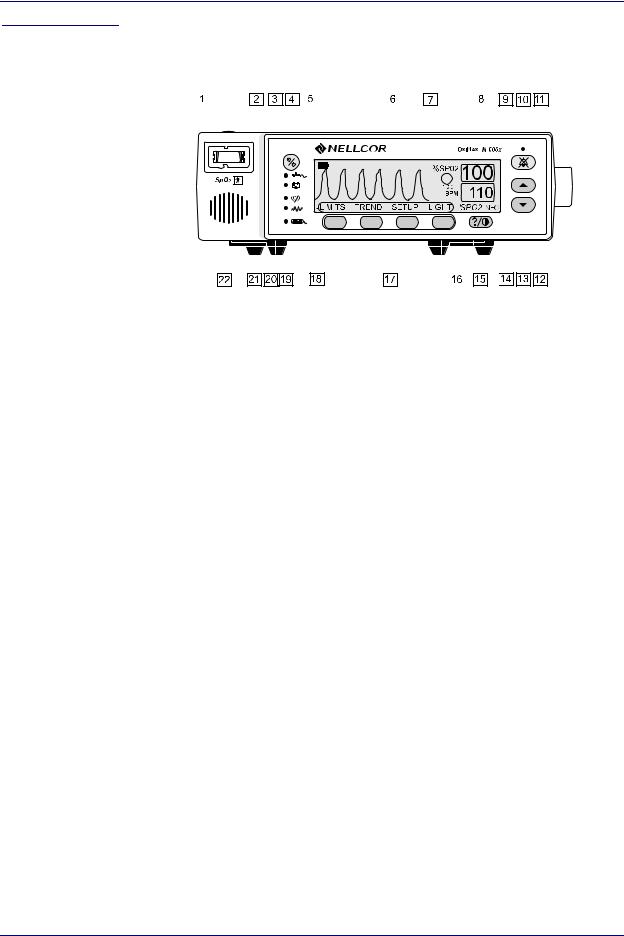
Introduction
Front Panel
|
|
|
|
|
|
|
|
|
|
|
|
|
|
|
|
|
|
|
|
|
|
|
|
|
|
|
|
|
|
|
|
|
|
|
|
|
|
|
|
|
|
|
|
|
|
|
|
|
|
|
|
|
|
|
|
|
|
|
|
|
|
|
|
|
|
|
|
|
|
|
|
|
|
|
|
|
|
|
|
|
|
|
|
|
|
|
|
|
|
|
|
|
|
|
|
|
|
|
|
|
|
|
|
|
|
|
|
|
|
|
|
|
|
|
|
|
|
|
|
|
|
|
|
|
|
|
|
|
|
|
|
|
|
|
|
|
|
|
|
|
|
|
|
|
|
|
|
|
|
|
|
|
|
|
|
|
|
|
|
|
|
|
|
|
|
|
|
|
|
|
|
|
|
|
|
|
|
|
|
|
|
|
|
|
|
|
|
|
|
|
|
|
|
|
|
|
|
|
|
|
|
|
|
|
|
|
|
|
|
|
|
|
|
|
|
|
|
|
|
|
|
|
|
|
|
|
|
|
|
|
|
|
|
|
|
|
|
|
|
|
|
|
|
|
|
|
|
|
|
|
|
|
|
|
|
|
|
|
|
|
|
|
|
|
|
|
|
|
|
|
|
|
|
|
|
|
|
|
|
|
|
|
|
|
|
|
|
|
|
|
|
|
|
|
|
|
|
|
|
|
|
|
|
|
|
|
|
|
|
|
|
|
|
|
|
|
|
|
|
|
|
|
|
|
|
|
|
|
|
|
|
|
|
|
|
|
|
|
|
|
|
|
|
|
|
|
|
|
|
|
|
|
|
|
|
|
|
|
|
|
|
|
|
|
|
|
|
|
|
|
|
|
|
|
|
|
|
|
|
|
|
|
|
|
|
|
|
|
|
|
|
|
|
|
|
|
|
|
|
|
|
|
|
|
|
|
|
|
|
|
|
|
|
|
|
|
|
|
|
|
|
|
|
|
|
|
|
|
|
|
|
|
|
|
|
|
|
|
|
|
|
|
|
|
|
|
|
|
|
|
|
|
|
|
|
|
|
|
|
|
|
|
|
|
|
|
|
|
|
|
|
|
|
|
|
|
|
|
|
|
|
|
|
|
|
|
|
|
|
|
|
|
|
|
|
|
|
|
|
|
|
|
|
|
|
|
|
|
|
|
|
|
|
|
|
|
|
|
|
|
|
|
|
|
|
|
|
|
|
|
|
|
|
|
|
|
|
|
|
|
|
|
|
|
|
|
|
|
|
|
|
|
|
|
|
|
|
|
|
|
|
|
|
|
|
|
|
|
|
|
|
|
|
|
|
|
|
|
|
|
|
|
|
|
|
|
|
|
|
|
|
|
|
|
|
|
|
|
|
|
|
|
|
|
|
|
|
|
|
|
|
|
|
|
|
|
|
|
|
|
|
|
|
|
|
|
|
|
|
|
|
|
|
|
|
|
|
|
|
|
|
|
|
|
|
|
|
|
|
|
|
|
|
|
|
|
|
|
|
|
|
|
|
|
|
|
|
|
|
|
|
1. |
SpO2 OXIMAX Sensor Port |
|
12. |
ADJUST UP Button |
|||||||||||||||||||||||||||||||||||||||||||||||||||
|
|||||||||||||||||||||||||||||||||||||||||||||||||||||||
|
|
|
|
|
|
|
|
|
|
|
|
|
|
|
|
|
|
|
|
|
|
|
|
|
|
|
|
|
|
|
|
|
|
|
|
|
|
|
|
|
|
|
|
|
|
|
|
|
|
|
|
|
|
|
|
2. |
Low Battery Indicator |
|
13. |
ADJUST DOWN Button |
|||||||||||||||||||||||||||||||||||||||||||||||||||
3. |
AC Power Indicator |
|
14. |
Neonate Mode Indicator |
|||||||||||||||||||||||||||||||||||||||||||||||||||
4. ON/STANDBY Button |
|
15. HELP/CONTRAST Button |
|||||||||||||||||||||||||||||||||||||||||||||||||||||
5. |
Battery Fuel Gauge Indicator |
|
16. |
Fast Response Mode Indicator |
|||||||||||||||||||||||||||||||||||||||||||||||||||
6. |
Waveform Display |
|
17. |
Softkeys |
|||||||||||||||||||||||||||||||||||||||||||||||||||
7. |
SatSecondsTM Indicator |
|
18. |
Menu Bar |
|||||||||||||||||||||||||||||||||||||||||||||||||||
8. %SpO2 Display |
|
19. |
Data In-Sensor Indicator |
||||||||||||||||||||||||||||||||||||||||||||||||||||
9. |
Pulse Rate Display |
|
20. |
Interference Indicator |
|||||||||||||||||||||||||||||||||||||||||||||||||||
10. Alarm Silence Indicator |
|
21. |
Pulse Search Indicator |
||||||||||||||||||||||||||||||||||||||||||||||||||||
11. ALARM SILENCE Button |
|
22. Monitor Speaker |
|||||||||||||||||||||||||||||||||||||||||||||||||||||
Figure 1: N-600x Front Panel
OXIMAX N-600x Service Manual |
5 |

Introduction
Rear Panel
1 |
2 |
|
3 |
|
|
|
|
|
|
|
|
|
|
|
|
|
|
|
|
|
|
|
|
|
|
|
|
Type BF
|
|
N-600x |
2X |
SN |
|
|
|
|
|
MADE IN IRELAND |
TYCO HEALTHCARE GROUP LP |
|
|
NELLCOR PURITAN BENNETT INCORPORATED |
T 0.50A 250V |
PLEASANTON, CA USA 94588 |
|
|
|
AUTHORIZED REPRESENTATIVE: |
|
|
TYCO HEALTHCARE UK LTD |
|
|
GOSPORT PO13 0AS, UK |
|
CISPR 11 |
|
|
Group 1 |
|
|
Class B |
|
|
|
100-120 200-240V |
0123 C |
US IPX1 |
50/60 Hz 30VA |
5 |
4 |
1.Equipotential Terminal (Ground)
2.AC Power Connector
3.Data Port Connector
4.Fuse Holder
5.Supply Voltage Selector Switch
Figure 2: N-600x Rear Panel
Softkey Menu
The monitor’s softkey menu hierarchy is outlined below. Choose the type of trend data to view by selecting the Monitor or Sensor trend data in the Trend menu. Sensor sub-menu choices differ depending on what type of patient alarm event data is stored in the sensor chip, such as, event or loop.
The menu structure includes BACK softkey options to return to the previous menu level without exiting the Trend menu entirely. Trend data must be compiled on entry or re-entry to the Trend menu. When the softkeys are available, both BACK and EXIT options are available. The BACK softkey returns to the previous level and the EXIT softkey returns to the Main menu. If only one space is available, the BACK softkey is included, this may require returning one or two levels to access an EXIT softkey.
The BACK and EXIT softkeys are positioned on the right-most softkeys, respectively.
The menu structure below identifies:
•BOLDFACE TYPE — softkey title as displayed on the monitor
•Underlined Text — description of the softkey menu item
•Italicized Text — the destination of the BACK and EXIT softkeys
6

Introduction
(Main Menu)
LIMITS (Limits Menu)
-SELECT
-NEO
-ADULT
EXIT (to Main menu)
TREND (Trend Menu)
-MON (Monitor Menu)
-- VIEW (Monitor Trend View Menu)
- |
- |
- |
DUAL |
|
|
|
- |
- |
- |
SPO2 |
|
|
|
- |
- |
- |
PULSE |
|
|
|
- |
- |
- |
NEXT (History/Amplitude Menu) |
|||
- |
- |
- |
- |
HIST (Delete/Print2 Menu) |
||
- |
- |
- |
- |
- |
DELETE (delete Trends) |
|
- |
- |
- |
- |
- |
- |
“DELETE TRENDS” |
- |
- |
- |
- |
- |
- |
- YES (return to Main menu) |
- |
- |
- |
- |
- |
- |
- NO (back to Delete/Print menu) |
- |
- |
- |
- |
- |
||
- |
- |
- |
- |
- BACK (back to Hist/Amp menu) |
||
- |
- |
- |
- |
- EXIT (to Main menu) |
||
- |
- |
- |
- |
AMP (Amplitude Menu) |
||
- |
- |
- |
- |
- BACK (back to Hist/Amp menu) |
||
- |
- |
- |
- |
- EXIT (to Main menu) |
||
- |
- |
- |
- BACK (back to Monitor Trend View menu) |
|||
- |
- |
- |
- EXIT (to Main menu) |
|||
-- ZOOM (Monitor Trend Zoom Menu)
- |
- |
- |
TIME (Cycle through 48h, 36h, 24h, 12h, 8h, 4h, 2h, 1h, 30m, 15m, |
|
|
|
40s, 20s for current view) |
- |
- |
- |
SCALE (Cycle through ±5, ±10, ±15, ±20, ±25, ±30, ±35, ±40 and |
|
|
|
±50 (units of BPM or %SpO2, depending on the data displayed) of |
|
|
|
the max and min. values under the cursor, default to 10-100 |
|
|
|
for SAT trend graph and 5-250 for Pulse trend graph if there is |
|
|
|
no data point under the cursor for current view) |
- |
- |
- |
AUTO (based on all of the graphed trend data: maximum value, |
|
|
|
rounded up to nearest multiple of 10, minimum value, rounded |
|
|
|
down to nearest multiple of 10 minus 10) |
- |
- |
- |
BACK (back to Monitor menu) |
-- NEXT (Delete/Print1 Menu)
- |
- |
- |
DELETE |
|
- |
- |
- |
- |
“DELETE TRENDS?” |
- |
- |
- |
- |
- YES (to Main menu) |
- |
- |
- |
- |
- NO (back to Delete/Print1 menu) |
- |
- |
- |
||
- |
- |
- BACK (back to Monitor menu) |
||
- |
- |
- EXIT (to Main menu) |
||
-- BACK (back to Trend menu)
-SENSOR (Sensor/Event Menu)
(if event data is in the sensor, the Graph menu, the screen remains in the appropriate state until the next menu selection is made)
-- GRAPH (Graph Menu) (display events #1-N, in inverse chronological
|
|
|
order; up/down also scroll through events in order) |
- |
- |
- |
< (show previous graph, only available when there is a previous |
|
|
|
graph) |
- |
- |
- |
> (show next graph, only available when there is a next graph) |
OXIMAX N-600x Service Manual |
7 |

Introduction
- |
- |
- |
|
- |
- |
- |
BACK (back to Sensor menu) |
-- TABLE (Table Menu)
- |
- |
- |
^ (show previous table, only available when there is a previous |
|
|
|
graph; bottom/top line repeats in new table) |
- |
- |
- |
v (show next table, only available when there is a next graph; |
|
|
|
bottom/top line repeats in new table) |
- |
- |
- |
|
- |
- |
- |
BACK (back to Sensor menu) |
-- BACK (back to Trend menu)
- - - EXIT (to Main menu)
(Sensor/Loop Menu) (If continuous-Loop data is in the sensor, the following displays)
-- VIEW (Sensor Trend View Menu)
- |
- |
- |
DUAL (shows %SPO2+BPM) |
- |
- |
- |
SPO2 |
- |
- |
- |
PULSE |
-- ZOOM (cycle through 2h, 1h, 30m, and 15m for current view)
-- BACK (to Trend menu)
-EXIT (to Main menu)
SETUP (Setup Monitor Menu)
-VIEW (Setup View Menu)
- |
- |
PLETH |
|
|
- |
- |
BLIP |
|
|
- |
- |
TREND |
|
|
- |
- |
- VIEW (RT Trend View Menu) |
||
- |
- |
- |
- |
DUAL |
- |
- |
- |
- |
SPO2 |
- |
- |
- |
- |
PULSE |
- |
- |
- |
- |
BACK |
- |
- |
- ZOOM (RT Trend View Menu) |
||
- |
- |
- |
- |
TIME |
- |
- |
- |
- |
SCALE |
- |
- |
- |
- |
AUTO |
- |
- |
- |
- |
BACK |
-- BACK (back to Setup menu)
-SENSOR (Setup Sensor Menu)
-- DATA (On-screen options for SENSOR-R (Write-once Sensor) sensor
|
|
are: “SPO2, SPO2+BPM, DEFAULT.” On-screen options for |
|
|
SENSOR-RW (rewritable sensor) are: “SPO2, SPO2+BPM, |
|
|
DEFAULT.” SELECT toggles SENSOR-R or SENSOR-RW |
|
|
sensor type; up/down keys scroll through options in order.) |
|
|
The SENSOR-R feature supports all of the current OXIMAX |
|
|
sensors. |
- |
- |
- SELECT |
- |
- |
- BACK (back to Setup Sensor menu) |
- |
- |
- EXIT (to Main menu) |
-- MSG (Sensor Set Message Menu)
- |
- |
- |
BACK (back to Setup Sensor menu) |
- |
- |
- |
EXIT (to Main menu) |
-NEXT (Clock/Language Menu)
-- CLOCK (Clock Menu)
- - - SET (Clock Set Menu)
8

|
|
|
|
Introduction |
|
|
|
|
|
- |
- |
- |
- |
SELECT (press select to toggle through hours, minutes, |
|
|
|
|
seconds, month, day, year; use up/down buttons to set each |
|
|
|
|
selection) |
- |
- |
- |
- |
BACK (back to Clock/Language menu) |
- |
- |
- |
- |
EXIT (to Main menu) |
- |
- |
- |
BACK (back to Clock/Language menu) |
|
- |
- |
- |
EXIT (to Main menu) |
|
-- LANG (Language Setup Menu) (use up/down buttons to toggle though
|
|
|
languages) |
- |
- |
- |
BACK (back to Clock/Language menu) |
-- NEXT (Communication/Nurse Call Menu)
- |
- |
- COMM (Communication Port Configuration Menu) |
|||
- |
- |
- |
- |
SELECT |
|
- |
- |
- |
- BACK (back to Communication/Language menu) |
||
- |
- |
- |
- EXIT (to Main menu) |
||
- |
- |
- |
NCALL (Nurse Call Menu) |
||
- |
- |
- |
- |
NORM + |
|
- |
- |
- |
- |
NORM - |
|
- |
- |
- |
- BACK (back to Communication/Nurse Call menu) |
||
- |
- |
- |
- EXIT (to Main menu) |
||
- |
- |
- |
NEXT (Analog/Mode Menu) |
||
- |
- |
- |
- ANALOG (Analog Voltage Select Menu) |
||
- |
- |
- |
- |
- |
0 VOLT |
- |
- |
- |
- |
- |
1 VOLT |
- |
- |
- |
- |
- |
STEP |
- |
- |
- |
- |
- BACK (back to Analog/Mode menu) |
|
- |
- |
- |
- |
MODE (Mode Menu) |
|
- |
- |
- |
- |
- BACK (back to Analog/Mode menu) |
|
- |
- |
- |
- |
- EXIT (to Main menu) |
|
- |
- |
- |
- BACK (back to Communication/Nurse Call menu) |
||
- |
- |
- |
- EXIT (to Main menu) |
||
- |
- |
- BACK (back to Clock/Language menu) |
|||
-- BACK (back to Setup menu)
-EXIT (to Main menu)
LIGHT (Light Menu)
-OFF (turns display backlight off)
-EXIT (to Main menu)
OXIMAX N-600x Service Manual |
9 |

Introduction
Related Documents
An understanding of the OXIMAX N-600x monitor is critical in order to perform the tests, troubleshoot procedures, use the principles of operation, and circuit analysis sections of this manual. Refer to the OXIMAX N-600x Operator's Manual. To utilize the various Nellcor approved OXIMAX sensors used with the monitor, refer to the individual OXIMAX Sensor's Directions for Use (DFU).
The OXIMAX N-600x Operator’s and Service Manuals are posted on the Internet at:
http://www.nellcor.com
A Spare Parts and Accessories list is also posted on the Internet at:
http://www.nellcor.com
10

Routine Maintenance
R o u t i n e M a i n t e n a n c e
Cleaning the Monitor
WARNING: Do not spray, pour, or spill any liquid on the N-600x, its accessories, connectors, switches, or openings in the chassis as this may damage the pulse oximeter.
For surface-cleaning and disinfecting follow your institution's procedures or use the steps outlined below:
To surface clean the monitor:
1.Obtain a soft cloth.
2.Dampen the cloth with either a commercial, non-abrasive cleaner or a solution of 70% alcohol in water.
3.Lightly wipe each exterior surface using the dampened soft cloth.
To disinfect the monitor:
1.Saturate a soft cloth with 10% solution of chlorine bleach in tap water.
2.Lightly wipe each exterior surface using the saturated soft cloth.
Caution: Before attempting to clean an SpO2 OXIMAX sensor, read the directions for use enclosed with the OXIMAX sensor. Each sensor model has specific cleaning instructions.
OXIMAX N-600x Service Manual |
11 |

Routine Maintenance
Periodic Safety Checks
The N-600x monitor requires no calibration. The battery should be replaced at least every two years. See Battery Replacement on page 88.
The following safety checks should be performed at least every 24 months by a qualified service technician.
To perform a periodic safety check:
1.Inspect the equipment for mechanical and functional damage.
2.Inspect safety labels for legibility.
3.Contact Nellcor’s Technical Services Department, 1.800.635.5267, or your local Nellcor representative if the labels are damaged.
Functional Checks
If the monitor has been visibly damaged or subjected to mechanical shock (for example, if dropped), immediately perform the performance tests. See
Performance Tests on page 16.
The following checks should be performed at least every two years by a qualified service technician.
To perform a functional check:
1.Perform the electrical safety tests detailed in Safety Tests on page 46. If the unit fails the tests, refer to Spare Parts on page 103.
2.Inspect the fuses for proper value and rating (F1 + F2 = 0.5 amp, 250 volts).
12

Routine Maintenance
Battery Operation
The N-600x has an internal battery that can be used to power the monitor during transport or when AC power is not available. A new, fully-charged battery provides at least seven hours of monitoring time under the following conditions:
•No audible alarms sound
•No analog or serial output devices are attached to the N-600x
•Default display brightness setting
The monitor cannot be used when the battery is depleted unless the monitor is connected to an AC power source. A warning message displays and must be cleared by pressing the ALARM SILENCE button twice before the monitor can be used for patient monitoring.
The pleth and blip displays include the Battery Fuel Gauge indicator that shows the remaining charge (operating hours). When the monitor is fully-charged, all four N-600x bars are lit on the indicator.
Note: After three months of storage, the battery may lose its charge. The N-600x will not power up until the AC power is established. On AC power up, the battery fuel gauge shows empty. The N-600x operates on AC power while the battery is charging. Until the battery is recharged, the message, “UNIT WILL SHUT DOWN IF AC POWER IS LOST” appears. The monitor is now operational. Press the ALARM SILENCE button twice to remove the message from the screen.
Caution: If the battery has been in storage for longer than six months, or if the battery does not fully recharge, the battery should be replaced. After the battery has been replaced and a new battery had been charged, an “EEE 575 Trends Lost” message appears when the N-600x is turned on. Turn the N-600x off and wait three seconds. Then turn the monitor on again. After the extended power-on self-test, the N-600x runs on AC or battery power.
Caution: To fully recharge the monitor, it may take up to eight hours if the monitor is turned off or 12 hours if the monitor is turned on. Connect the monitor to an AC power outlet to charge a low or fully-depleted battery.
Caution: The battery terminal clips may loosen after repeated insertions. After replacing the battery, check the battery terminal clips for secure fit and tighten if necessary (needle nose pliers may be used).
WARNING: If the monitor is operating on an AC power source with a fullydepleted battery and the AC power is subsequently lost, the monitor will shut down immediately.
OXIMAX N-600x Service Manual |
13 |

Routine Maintenance
When all of the following conditions are present for 15 minutes, the N-600x automatically shuts down:
•Monitor is running on battery power
•No buttons have been pressed
•No pulse has been detected (for example, when a patient is not connected to the OXIMAX sensor or the OXIMAX sensor is disconnected from the monitor)
•No alarms are present (other than low battery or a non-correctable error)
Note: Whenever the monitor is connected to an AC power source, the battery is being charged. We recommend the monitor remain connected to an AC power source when not in use. This ensures full battery power when the monitor is needed.
Caution: Repeated deep discharge reduces the life of the battery.
14
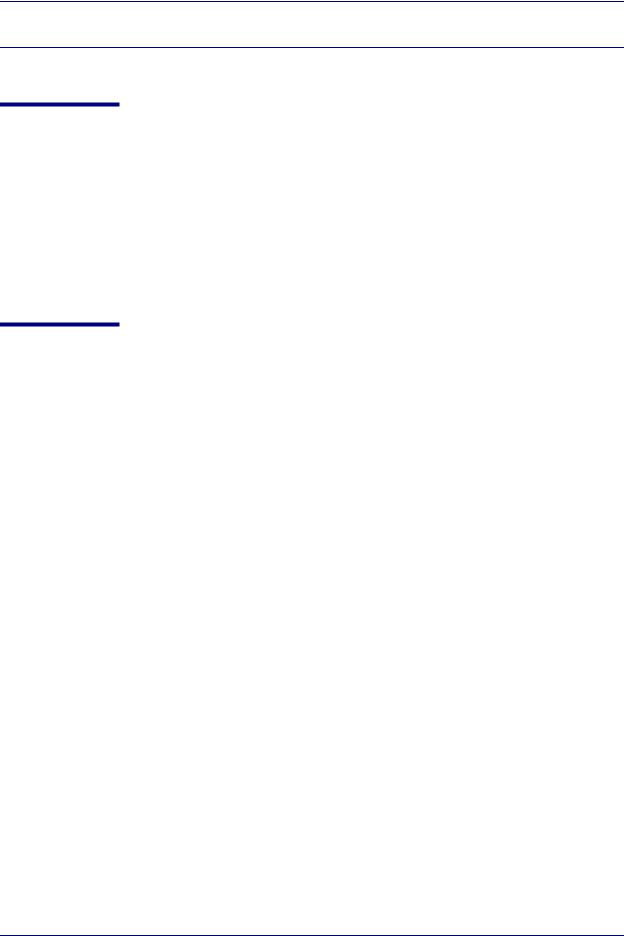
Performance Verification
P e r f o r m a n c e V e r i f i c a t i o n
Overview
This section discusses the tests used to verify performance following repairs or during routine maintenance. All tests can be performed without removing the N-600x cover. All tests except the battery charge and battery performance tests must be performed as the last operation before the N-600x is returned to the Caregiver.
If the N-600x fails to perform as specified in any test, repairs must be made to correct the problem before the monitor is returned.
Required Equipment
Table 1: Equipment and Descriptions
Equipment |
Description |
|
|
Digital Multimeter (DMM) |
Fluke Model 87 or equivalent |
|
|
Durasensor® OXIMAX Oxygen |
DS-100A sensor |
Sensor |
|
|
|
OXIMAX Oxygen Sensor |
MAX-A sensor |
|
|
Safety Analyzer |
Must meet current AAMI ESI/1993 & IEC |
|
60601-1/1998 specifications |
|
|
Pulse Oximetry Cable |
DOC-10 cable |
|
|
Data Interface Cable |
EIA-232 cable (optional) |
|
|
Stop Watch |
Manual or electronic |
|
|
Nellcor model SRC-MAX Tester |
Provides testing for DigiCal compatible |
|
Monitors |
|
|
OXIMAX N-600x Service Manual |
15 |
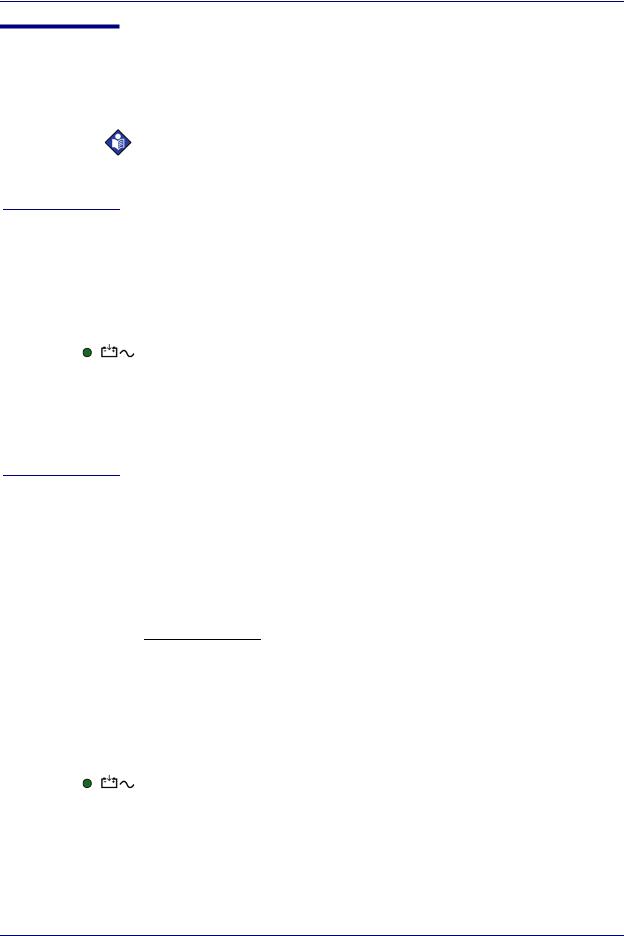
Performance Verification
Performance Tests
The battery charge procedure should be performed before monitor repairs when possible.
Note: This section uses Nellcor factory defaults. If your institution has custom defaults, those values are displayed. Factory defaults can be restored (see
Reset Softkey on page 53).
Battery Charge
To fully charge the battery:
1. Connect the monitor to an AC power source.
2. Verify the monitor is off and the AC Power/Battery Charging indicator is lit.
3.Charge the battery for at least eight hours with the monitor turned off or twelve hours with the monitor turned on.
Power-Up Performance
The power-up performance tests verify the following monitor functions:
•Power-On Self-Test (POST) on page 16
•Power-On Defaults and Alarm Range Limits on page 19
Power-On Self-Test (POST)
To perform the power-on self-test:
1. Connect the monitor to an AC power source.
2. Verify the monitor is off and the AC Power indicator is lit.
3. Do not connect any cables to the monitor.
16

Performance Verification
4.Turn on the N-600x by pressing the ON/STANDBY button. Observe the monitor front panel. The monitor must perform the following:
•Within ten seconds, all LEDs, pixels and the backlight are illuminated.
•The indicators remain lit for two seconds.
•The LCD display shows NELLCOR and the software version of the
N-600x.
Note: The software version displayed in the example below is x.x.x.x.
®
N - 600x VERSION x.x.x.x
•A three beep power on tone sounds, followed by a one-second beep, indicating proper operation of the speaker and successful completion of the power on self tests. All indicators turn off except the AC Power/ Battery Charging indicator and the LCD screen.
•The monitor begins normal operation.
WARNING: If the N-600x monitor does not sound any audible tones during the power-on self-test (POST), please contact Nellcor’s Technical Services or your local Nellcor representative.
OXIMAX N-600x Service Manual |
17 |
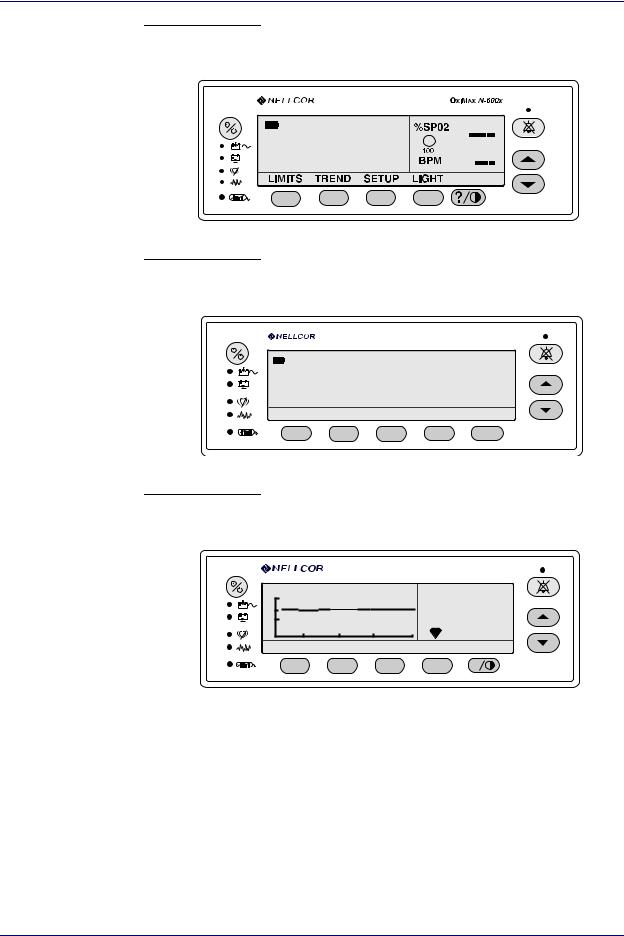
Performance Verification
PLETH Display
BLIP Display
|
OXIMAX N-600x |
%SP02 |
BPM |
100 |
100 |
--- 85 |
--- 40 |
LIMITS TREND SETUP LIGHT
?

REAL-TIME TREND Display
|
|
OXIMAX N-600x |
|
|
30 MIN SPO2 |
%SP02 |
---10 |
120 |
|
||
110 |
|
|
|
100 |
|
BPM |
--- |
90 |
|
BPM |
110 |
LIMITS TREND SETUP LIGHT |
|
||
|
|
|
? |
18

Performance Verification
Power-On Defaults and Alarm Range Limits
Note: When observing or changing alarm limits, a time-out is in effect (approximately ten seconds). If no action is taken within the time-out, the monitor automatically returns to the monitoring display.
Note: The descriptions below are based on the assumption that the Pleth view is selected.
The steps for changing an alarm limit are the same if the view being used is the Blip (Magnified) view.
Note: Power-on defaults are the factory-set or the defaults set by your institution.
To test the power-on and alarm range settings:
1.Turn on the monitor by pressing the ON/STANDBY button.
2.Press the LIMITS softkey.
3.Verify the monitor emits a single beep and the Pleth view is replaced with a display of the alarm limits. The selected Upper Alarm Limit for %SpO2 indicates an alarm limit of “100” (or the applicable institutional default setting).
OXIMAX N-600x
|
ADULT LIMITS |
BPM |
%SP02 |
|
%SPO2 |
||
|
|
||
UPPER |
100 |
170 |
|
LOWER |
85 |
40 |
BPM |
SAT-S |
OFF |
|
|
100
110
SELECT NEO ADULT EXIT
?

4.Press and hold the ADJUST DOWN button. Verify the selected number for %SpO2 Upper Alarm Limit decreases to a minimum of “86.”
Note: A decimal point in the display indicates the alarm limits have been changed from the factory default values.
OXIMAX N-600x Service Manual |
19 |

Performance Verification
5.Press the SELECT softkey. Verify the monitor emits a single beep and the %SpO2 Lower Alarm Limit of “85” (or your institutional default setting) is selected.
OXIMAX N-600x
|
ADULT LIMITS |
BPM |
%SP02 |
|
%SPO2 |
||
|
|
||
UPPER |
86 |
170 |
|
LOWER |
85 |
40 |
BPM |
SAT-S |
OFF |
|
|
100
110
SELECT NEO ADULT EXIT
?

6.Press and hold the ADJUST DOWN button. Verify the %SpO2 Lower Alarm Limit display reduces to a minimum of “20.”
7.Press and hold the ADJUST UP button. Verify the %SpO2 Lower Alarm Limit display cannot be raised past the Upper Alarm Limit setting of “85.”
8.Press the LIMITS softkey.
9.Press the SELECT softkey three consecutive times. Verify the monitor emits a beep after each keystroke. The selected Pulse Upper Alarm Limit should be “170.”
OXIMAX N-600x
|
ADULT LIMITS |
BPM |
%SP02 |
100 |
|
|
%SPO2 |
||||
|
|
||||
|
|
|
|||
UPPER |
86 |
170 |
BPM 110 |
||
LOWER |
85 |
40 |
|||
SAT-S |
|||||
OFF |
|
|
|
||
SELECT NEO ADULT EXIT
?

10.Press and hold the ADJUST DOWN button. Verify the minimum displayed value is “41” for the BPM Upper Alarm Limit.
11.Press the LIMITS softkey.
20
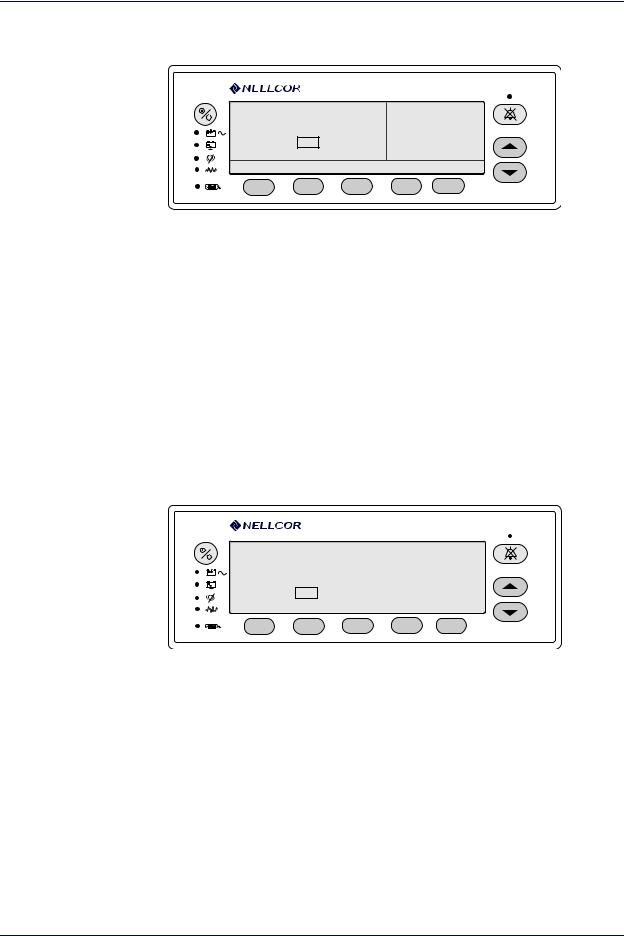
Performance Verification
12.Press the SELECT softkey four consecutive times. Verify the selected Pulse Rate Lower Alarm Limit display indicates an alarm limit of “40.”
OXIMAX N-600x
|
ADULT LIMITS |
BPM |
%SP02 |
|
%SPO2 |
||
|
|
||
UPPER |
86 |
41 |
BPM |
LOWER |
85 |
40 |
|
SAT-S |
OFF |
|
|
100
110
SELECT NEO ADULT EXIT
?

13.Press and hold the ADJUST DOWN button. Verify the selected Pulse Rate Lower Alarm Limit display decreases to a minimum of “30.”
14.Press and hold the ADJUST UP button. Verify the selected Pulse Rate Lower Alarm Limit display cannot be adjusted above the Pulse Rate Upper Alarm Limit of “40.”
15.Press the LIMITS softkey.
16.Press the SELECT softkey twice. Verify the SatSeconds SAT-S alarm is selected.
OXIMAX N-600x
|
ADULT LIMITS |
BPM |
%SP02 |
100 |
|
%SPO2 |
|||
|
|
|||
|
|
|
||
UPPER |
86 |
41 |
BPM 110 |
|
LOWER |
85 |
40 |
||
SAT-S |
OFF |
|
|
|
SELECT NEO ADULT EXIT
?

17.Press the ADJUST UP button repeatedly until the SatSeconds alarm display cycles from OFF through 10, 25, 50, 100, and OFF.
18.Press the ON/STANDBY button to turn the monitor off.
19.Press the ON/STANDBY button to turn the monitor back on.
20.Press the LIMITS softkey. Verify the selected %SpO2 Upper Alarm Limit display indicates an alarm limit of “100.”
OXIMAX N-600x Service Manual |
21 |

Performance Verification
21.Ensure the selected %SpO2 Lower Alarm Limit display indicates an alarm limit of “85.”
22.Confirm the SatSeconds SAT-S alarm is OFF.
23.Ensure the Pulse Rate Upper Alarm Limit display is selected and indicates an alarm limit of “170.”
24.Ensure the Pulse Rate Lower Alarm Limit display is selected and indicates an alarm limit of “40.”
25.Press the ON/STANDBY button to turn the monitor off.
Operational Setup
The Operational Setup procedures confirm and configure the following parameters:
•Alarms and Alarm Silence on page 23
•Alarm Volume Control on page 25
•Pulse Tone Volume Control on page 26
•Nurse Call on page 26
•Using the Analog Output on page 27
•Using Battery Power on page 29
22
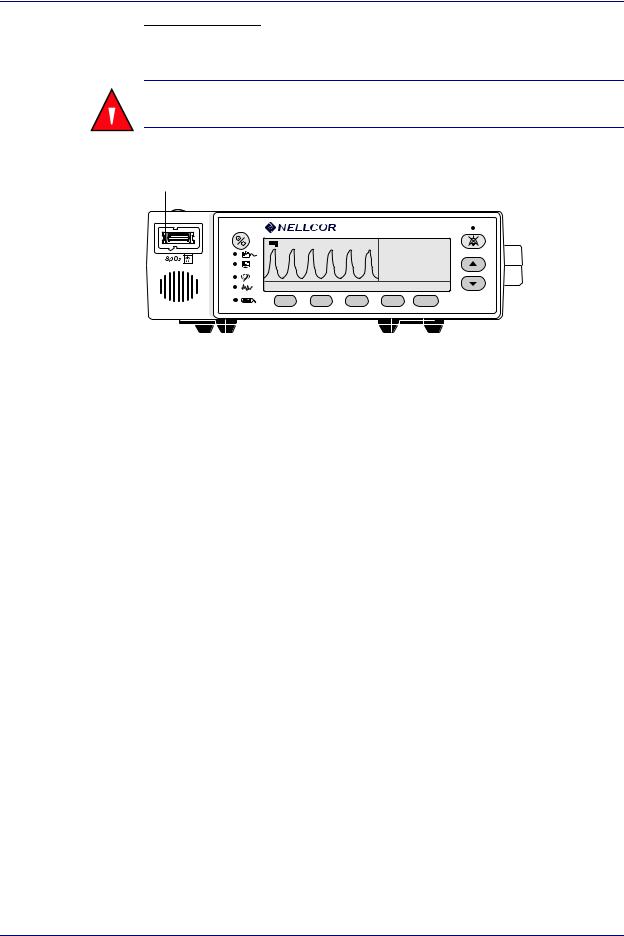
Performance Verification
Alarms and Alarm Silence
WARNING: Pressing ALARM SILENCE will keep ALL alarms from sounding for the alarm silence duration period.
SpO2 OXIMAX
Sensor Port
OXIMAX N-600x
%SP02 100
BPM 110
LIMITS TREND SETUP LIGHT
?

To adjust the alarms and alarm silence options:
1.Connect the DOC-10 pulse oximetry cable to the monitor’s SpO2 OXIMAX sensor port.
2.Connect the DS-100A OXIMAX sensor to the DOC-10 cable and your finger.
3.Press the ON/STANDBY button to turn the monitor on.
4.Press SETUP and then VIEW.
5.Press the Pleth softkey. Verify the %SpO2 and BPM indicate the %SpO2 and pulse rate.
6.Press the LIMITS softkey.
7.Press the SELECT softkey to select %SpO2 Lower Alarm Limit.
8.Press the ADJUST UP button until the %SpO2 Lower Alarm Limit indicates 99.
9.Press the SELECT softkey three consecutive times to select Pulse Rate Lower Alarm Limit.
OXIMAX N-600x Service Manual |
23 |

Performance Verification
10.Press the ADJUST UP button until the Pulse Rate Lower Alarm Limit indicates 160.
11.Confirm the following monitor results:
•The Plethysmograph waveform tracks the pulse rate.
•The Pulse Tone is audible.
•The %SpO2 and pulse rate are flashing in the %SpO2 and BPM displays.
•The Audible Alarm sounds, indicating both parameters have violated the alarm limits.
12.Press and hold the ALARM SILENCE button until the BPM display indicates “SEC.”
13.Continue to press the ALARM SILENCE button. Press the ADJUST DOWN button until “60” appears in the %SpO2 display.
14.Press the ALARM SILENCE button.
15.With the monitor’s alarm silenced, verify the:
•alarm remains silenced for 60 seconds
•Alarm Silence indicator lights
•%SpO2 and BPM displays continue to flash
•pulse tone is audible
•audible alarm returns in approximately 60 seconds
16.Press and hold the ALARM SILENCE button until the BPM display indicates “SEC.” Continue to press the ALARM SILENCE button and press the ADJUST DOWN button until “30” appears in the %SpO2 display.
17.Press the ADJUST UP button. Verify the displays indicate 60 SEC, 90 SEC, 120 SEC, and OFF. Release the ADJUST UP button once the display indicates “OFF.” “OFF” will only be displayed if the “ALLOW OFF” option was enabled in the Service menu.
24
